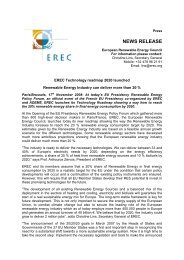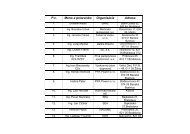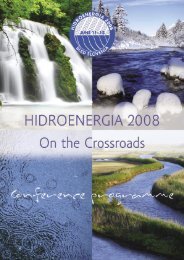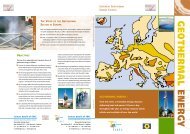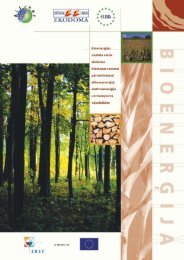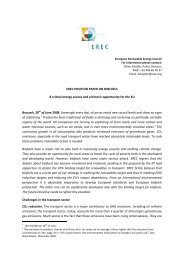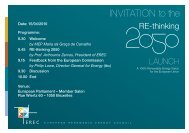CTO Assessment - European Commission
CTO Assessment - European Commission
CTO Assessment - European Commission
You also want an ePaper? Increase the reach of your titles
YUMPU automatically turns print PDFs into web optimized ePapers that Google loves.
The 6 th RTD Framework Programme<br />
of Research and Technological<br />
Development (2002-2006) adopted<br />
in 2002 allocates 810 million Euros<br />
to technological progress in the field<br />
of new and renewable energy sources<br />
and energy efficiency across the <strong>European</strong><br />
Union and the Accession<br />
Countries;<br />
ALTENER was a Community<br />
programme that focused exclusively<br />
on the promotion of renewable energy<br />
sources. It was part of the Energy<br />
Framework Programme, being until<br />
this moment a strong instrument to<br />
support and monitor the Community.<br />
Strategy on RES and, consequently<br />
its Campaign for Take-Off. Support<br />
to the Campaign under ALTENER<br />
provided funding for the promotional<br />
actions (advertising support for the<br />
Campaign for Take-Off, developing<br />
project implementation plans,<br />
identifying candidates for specific<br />
actions such as the "100 communities",<br />
developing specific marketing ...).<br />
The Intelligent Energy for Europe<br />
(2003 – 2006) multi-annual energy<br />
program that entered into force in<br />
August 2003 and that is intended to<br />
support the <strong>European</strong> Union’s policies<br />
in the field of energy as laid down in<br />
the different legislative documents<br />
such as the White Paper on Transport<br />
and other related Community<br />
legislation.<br />
The <strong>CTO</strong> was designed to act as a<br />
catalyst for the development of promising<br />
key sectors in the field of renewable<br />
energy sources: solar, wind<br />
and biomass technologies. The signal<br />
was meant to be a growing use of renewables,<br />
drawing attention to investment,<br />
innovation and sustainable<br />
labour market perspectives. In order<br />
to translate this signal to market actors<br />
in tangible objectives, the following<br />
targets were set for each key sector:<br />
1,000,000 kW p<br />
photovoltaic<br />
systems.<br />
15 million m 2 of solar thermal<br />
collectors.<br />
10,000 MW of wind turbine generators.<br />
10,000 MW th<br />
of combined heat and<br />
power biomass installations.<br />
1,000,000 dwellings heated by biomass<br />
1,000 MW of biogas installations.<br />
5 million tonnes of liquid biofuels.<br />
These targets proposed to be attained<br />
by 2003 correspond to a limited share<br />
(between 15% and 25%) of the overall<br />
2010 objective put forth in the<br />
White Paper for the sector in question.<br />
This share takes into account the<br />
1999 status of development of the<br />
particular sector, the highest percentage<br />
(25%) for example, being set for<br />
wind energy.<br />
In the context of the <strong>CTO</strong>, the activities<br />
to be implemented in these key<br />
sectors, were, since the beginning of<br />
the Campaign, classified according<br />
to: regional level, local, city, isolated<br />
or rural areas, national, industry and<br />
island, as well as “100% community”<br />
types in three levels - rural, islands<br />
and city.<br />
For each type of territory an estimation<br />
of the capacity to be installed has<br />
been made and the indicative costs<br />
of each application in the territory<br />
concerned have been estimated. These<br />
costs included the average unit cost<br />
during the period of the Campaign<br />
and the total investment needed.<br />
It was estimated that the renewables<br />
capacity promoted in the Campaign<br />
required investment funding of<br />
around Euro 30 billion with some<br />
75-80% coming from private sources.<br />
Therefore strong commitment from industry<br />
and other potential investors<br />
was crucial to the Campaign.<br />
In 1999, the <strong>European</strong> <strong>Commission</strong><br />
established the scope and the implementation<br />
rules for the <strong>CTO</strong> introducing<br />
the comments and contributions<br />
received from the Council and the<br />
<strong>European</strong> Parliament. The Campaign<br />
for Take-Off was decided to be a<br />
means to raise interest among industry,<br />
investors and the public, as well<br />
as to be a visible vehicle to enable<br />
the uptake of RES in Europe. The<br />
Campaign investment opportunities<br />
were highlighted by promotional activities,<br />
completed with public funding,<br />
both organized in a way to focus<br />
on the key sectors in order to increase<br />
the impact and visibility of the concerted<br />
efforts.<br />
At the same time the cooperation with<br />
the Member States’s action is seen to<br />
be a crucial point for the success of<br />
the campaign. Therefore the coordination<br />
between the EU, national and<br />
local levels of implementation of the<br />
RES objectives, in particular the relevant<br />
programmes and projects at<br />
these levels, are seen to be part of the<br />
Community-wide Campaign for Take-<br />
Off and can therefore benefit in practice<br />
from the various promotional activities.<br />
By this the <strong>CTO</strong> intended to<br />
6<br />
The Campaign



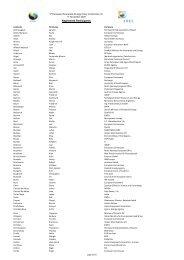
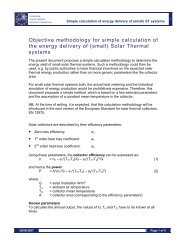

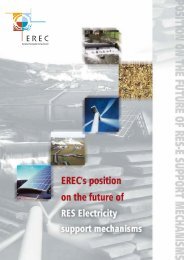

![Energy [R]evolution - Greenpeace](https://img.yumpu.com/47174859/1/184x260/energy-revolution-greenpeace.jpg?quality=85)
